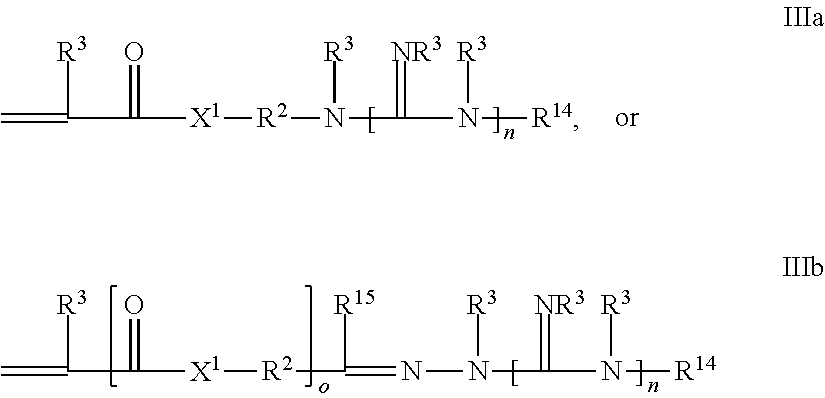Nonwoven article grafted with copolymer
a technology of copolymer and nonwoven articles, applied in membrane technology, weaving, membranes, etc., can solve the problems of increasing the occurrence of problematic channeling, severe bottlenecking problems, and low throughput using chromatography
- Summary
- Abstract
- Description
- Claims
- Application Information
AI Technical Summary
Problems solved by technology
Method used
Image
Examples
example 1
[0153]A 30 cm by 43 cm sample of the melt-blown polypropylene microfiber (PP) nonwoven substrate described above (Effective Fiber Diameter of 4.3 micrometers, basis weight of 90 grams per square meter, solidity of 10%) was purged of air under a nitrogen atmosphere in a glove box and inserted into a ZIPLOC™ plastic bag and sealed. The sealed bag was then removed from the glove box and irradiated to a dose level of 40 kGy by passing it through an Energy Sciences, Inc. ‘Electrocurtain’ CB-300 electron beam in a single pass operation at a web speed of approximately 5.5 meters / minute (18-19 feet / min) and an accelerating voltage of 300 kV. After returning the sealed bag to the nitrogen atmosphere-controlled glove box, the irradiated nonwoven substrate was removed and placed inside a non-irradiated, nitrogen purged, ZIPLOC™ bag.
[0154]The freshly prepared nonwoven sample was imbibed with 100 grams of the nitrogen purged imbibing solution (described above) and the bag resealed after expellin...
example 2
[0157]A grafted nonwoven was prepared as in Example 1, except the NVP / GMA / MAPTAC monomer concentrations by weight were; 14% / 6% / 8.5% respectively. The irradiated nonwoven was imbibed with 104 grams of nitrogen purged imbibing solution (described above). The Autoclave Wash Procedure was followed except 30.5 cm by 43.2 cm (12 inch by 17 inch) sheets were autoclave washed in 2 liters of DI or saline water and were vacuum rinsed after each autoclave cycle and the sheets were allowed to equilibrate in a 1% saline solution. The sheets were allowed to dry without any edge restraints. Four gram specimens were then cut out from the sheets and tested for Dry Autoclave TOC, and Yeast / Molasses throughput. The results are shown in Table 1 below. The higher monomer ratio content of GMA improved the overall grafting yield. The Graft Yield data in Table 1 includes about 8% retention of ambient moisture and is not subtracted.
[0158]
TABLE 1DryY / MExampleGraft Yield (%)Autoclave TOC (ppm)Throughput (ml)1...
examples 3-4
[0159]A grafted nonwoven was prepared as in Example 1 above except 105 gram quantities of imbibing solution were prepared in DI water, each containing 25.6 wt % total mixed monomers. The compositions of the imbibing solution are shown in Table 2 below. The imbibing solution used to prepare Example 3 contained only NVP, MAPTAC, and GMA monomers and water. The imbibing solution used to prepare Example 4 contained all 3 monomers, NVP, MAPTAC, and GMA in the same concentrations as Example 3, but with an additional 0.5 wt % of DOS.
[0160]The imbibing solutions were used for grafting the monomers onto a polypropylene nonwoven (Effective Fiber Diameter of 4 micrometers, basis weight of 90 grams per square meter, 10.2% solidity) following the procedure of Example 1. After grafting in a substantially oxygen-free environment for 16 hours, each of the samples was vacuum flushed 20 times with 600 mL of 14 mM NaCl solution on a vacuum wash stand. It was then immersed in 10 L of deionized water an...
PUM
| Property | Measurement | Unit |
|---|---|---|
| pore size | aaaaa | aaaaa |
| diameter | aaaaa | aaaaa |
| diameter | aaaaa | aaaaa |
Abstract
Description
Claims
Application Information
 Login to view more
Login to view more - R&D Engineer
- R&D Manager
- IP Professional
- Industry Leading Data Capabilities
- Powerful AI technology
- Patent DNA Extraction
Browse by: Latest US Patents, China's latest patents, Technical Efficacy Thesaurus, Application Domain, Technology Topic.
© 2024 PatSnap. All rights reserved.Legal|Privacy policy|Modern Slavery Act Transparency Statement|Sitemap



